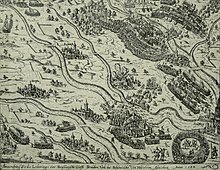Strasbourg Bishops' War

The Strasbourg Bishops' War[a] (1592–1604) was a conflict between Protestants and Catholics for control of the Bishopric of Strasbourg. It was one of only two sectarian or confessional conflicts, both highly localised, that occurred within the Holy Roman Empire between the Peace of Augsburg (1555) and the outbreak of the Thirty Years' War (1618). It was less bloody than the Cologne War (1583–88).[1] It coincided with the Counter-Reformation and the Spanish Winter (1598–99), and the Catholic victory caused Protestants in Germany great worry that the tide had turned decidedly against them.[1]
At the start of the war, Strasbourg was a Protestant-majority city and its cathedral chapter comprised twelve Protestants and seven Catholics.[2] The immediate cause of the war was the death of Bishop Johann von Manderscheid and the disputed election to replace him.[2][3] The Protestants feared the powerful Cardinal Charles of Lorraine, whom the Catholic canons had invited to join the chapter in 1585, and who stood for election as bishop.[2][3] To hedge against this, the Protestants seized the episcopal offices and held their own election on 20 May to replace Manderscheid.[4] Their choice fell upon the 15-year-old Johann Georg, son of the Elector of Brandenburg, Joachim III Frederick.[2] This decision was designed to unite Protestants across Germany behind them.[2] On this occasion, Johannes Pappus, president of the Compagnie des Pasteurs (Kirchenconvent), delivered a sermon on the "ministry, character and election of a bishop", but only the Protestants were present to hear it.[4] After the election, the Catholic canons had fled to Saverne and there elected Charles bishop in opposition to Johann Georg on 9 June.[2][4]
At first, the Protestants purchased the support of Duke Frederick I of Württemberg by accepting from him a loan of 300,000 florins. In turn Johann Georg ceded to Württemberg the district of Oberkirch, which connected the duchy to two of its enclaves in Alsace.[2] Frederick's son, Louis Frederick, aged six, was made a canon and promised the succession to Johann Georg.[2]
In the first year of the war, locally-raised troops under Christian of Anhalt halted the invasion of Charles of Lorraine.[2] At Saverne, Charles was joined by his 20-year-old brother Francis, who brought with him forty cavalrymen.[3] Charles's war treasury, managed at Paris by his treasurer, Stefano del Poggio, disbursed 15,386 francs during his time at Saverne, and in 1593 another 35,392 francs were spent on military ventures in Alsace.[3]
The reclusive Emperor Rudolph II refused to mediate the conflict, and so Henry IV of France—a Protestant convert to Catholicism—intervened in 1593. In September, he secured the division of the bishopric between the contending prelates: seven districts, including Saverne, went to Charles and six, including Oberkirch, to Johann Georg.[2] Charles felt compelled to apologise to King Philip II of Spain, whose Catholic troops were at that moment fighting the Protestant Dutch, for this compromise.[3] This provisional state persisted until 1604, when the Duke of Württemberg offered to pension Johann Georg and pay off his debts if he would resign the bishopric to Charles. This he did, and in return Charles ceded Oberkirch to Württemberg for a term of thirty years.[2] The Bishops' War turned out to be less about confessionalism than the dynastic interests of the House of Württemberg.[2]
Notes
- ^ Guerre des évêques in French; Bischöflichen Krieg in German.
Sources
- Bornert, René (1981). La réforme protestante du culte à Strasbourg au XVIe siècle (1523–1598): Approche sociologique et interprétation théologique. Brill.
- Monter, E. William (2007). A Bewitched Duchy: Lorraine and Its Dukes, 1477–1736. Librairie Droz.
- Wilson, Peter Hamish (2011). The Holy Roman Empire, 1495–1806 (2nd ed.). Palgrave MacMillan.
- Wilson, Peter Hamish (2009). The Thirty Years War: Europe's Tragedy. Harvard University Press.
